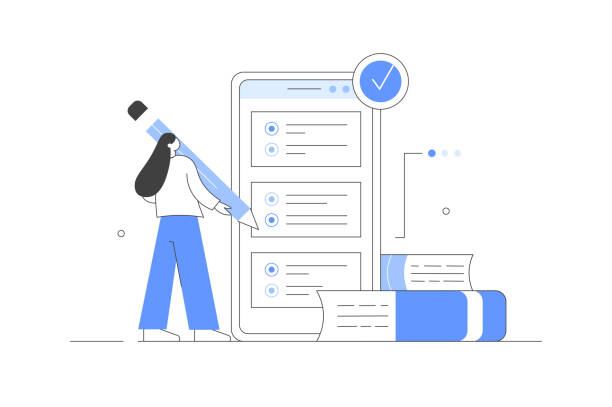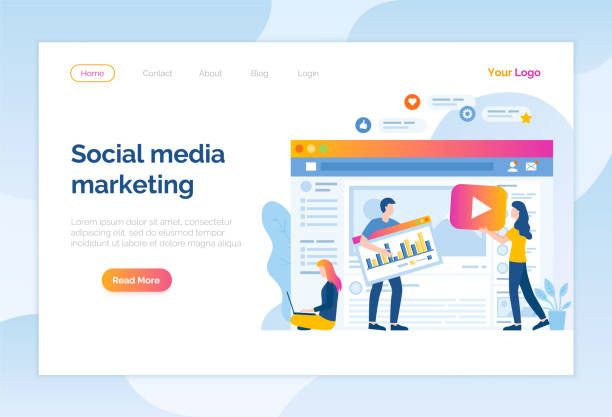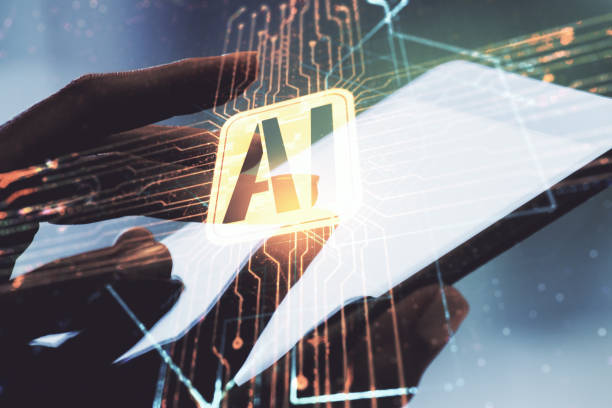Introduction to the Importance of Secure Website Design in Today’s World

In today’s fast-paced world, where millions of new websites come into existence every day, the topic of #Cybersecurity and #SecureWebsiteDesign has become more important than ever.
Websites are not just showcases for businesses, but also a place for vital interactions, exchange of personal information, and financial transactions.
Without a robust strategy for secure website design, every website is exposed to countless threats that can lead to the loss of sensitive data, damage to business reputation, and even irreparable financial losses.
For this reason, a deep understanding of the principles and techniques for securing websites is not just an option, but a vital necessity.
This section, in an explanatory and informative manner, addresses the necessity of security in the online space and examines comprehensive solutions for increasing resistance against cyberattacks.
The ultimate goal is to provide a reliable and protected digital platform for users that always has the necessary resistance against new threats.
Did you know that your customers’ first impression of your company is your website? With a powerful corporate website from Rasaweb, multiply your business’s credibility!
✅ Custom and eye-catching design tailored to your brand
✅ Improved user experience and increased customer acquisition
⚡ Get a free consultation!
Fundamentals and Key Principles in Website Security

To begin any activity in the field of secure website design, understanding the fundamentals and key principles of web security is essential.
The three main pillars of information security include Confidentiality, Integrity, and Availability, collectively known as the CIA Triad.
Confidentiality means ensuring that only authorized individuals can access information.
Integrity means preserving the accuracy and completeness of data and preventing unauthorized changes, and Availability ensures that systems and data are always accessible to authorized users.
This section, in an educational and specialized manner, introduces these foundational concepts and how to implement them in the secure website design process.
Furthermore, we will examine the most common web vulnerabilities such as SQL Injection, Cross-Site Scripting (XSS), and Cross-Site Request Forgery (CSRF), which every web designer should be familiar with to implement necessary preventive measures.
Understanding these principles is the cornerstone of any comprehensive approach to providing cybersecurity and developing resilient websites.
Choosing the Right Platform and Hosting for Secure Website Design

One of the most important decisions on the path to secure website design is choosing a suitable platform and hosting (web hosting).
Hosting is like your website’s home, and its security directly impacts your site’s overall security.
A reputable hosting provider should offer strong security features such as advanced firewalls (WAF), DDoS protection, regular security scans, and automatic and regular data backups.
Choosing a Content Management System (CMS) is also crucial; platforms like WordPress, Joomla, or Drupal should always be updated to the latest versions, as older versions often have known vulnerabilities that can be exploited by attackers.
This section, in a guiding and specialized manner, examines the security features you should consider when choosing hosting and platforms.
Paying attention to small details at this stage can prevent major problems in the future. In the table below, we compare important security features when choosing hosting providers:
| Security Feature | Description | Importance |
|---|---|---|
| Firewall (WAF) | Protection against web attacks, blocking malicious traffic | Very High |
| Regular Backup | Ability to restore information in case of problems | Very High |
| DDoS Protection | Prevents site shutdown due to fake traffic | High |
| Malware Scan | Identifies and removes malware from the server | Medium to High |
| Free SSL Certificate | Encrypts communications and increases user trust | Very High |
Informed choice at this stage will be the first and very strong step towards securing your website and protecting your website.
The Role of SSL/TLS Certificates in Secure Website Design and Building Trust

One of the most important and prominent signs of secure website design is the presence of an SSL/TLS certificate, which is recognizable by the green padlock and the HTTPS prefix in the browser’s address bar.
This certificate is responsible for encrypting communications between the user and the website server and prevents eavesdropping on sensitive information such as usernames, passwords, and banking card details by attackers.
The TLS (Transport Layer Security) protocol, which is a more advanced version of SSL, ensures the confidentiality and integrity of data.
This section, in an explanatory and educational manner, fully describes the functionality of SSL/TLS certificates, their types (such as DV, OV, EV), and their importance in building user trust.
In addition to security, the presence of SSL/TLS also positively impacts website ranking in search engines like Google, making it a critical factor for SEO.
Failure to use SSL/TLS can easily expose your website to serious risks and erode user trust.
Therefore, in any secure website design project, the correct installation and configuration of an SSL/TLS certificate is an essential and indispensable step.
Do visitors leave your e-commerce site before making a purchase? Don’t worry anymore! With Rasaweb’s professional e-commerce website design services, solve the problem of visitors not converting into customers forever!
✅ Significant increase in conversion rates and sales
✅ Unique and engaging user experience
⚡ Contact us now for a free consultation!
Securing Databases and Preventing SQL Injection

The database is the beating heart of any website, storing vital user information, products, and content.
Therefore, securing the database is an inseparable part of secure website design.
One of the most common and dangerous attacks against databases is SQL Injection, which allows attackers to access, modify, or even delete data by injecting malicious SQL code into website inputs.
This section, in a specialized and analytical manner, discusses methods to prevent SQL Injection attacks.
Using parameterized queries (Prepared Statements), Input Validation, and employing ORM (Object-Relational Mapping) are among the best methods to prevent these types of attacks.
Furthermore, special attention should be paid to issues such as using strong and unique passwords for the database, restricting access (Principle of Least Privilege), and regularly updating the Database Management System (DBMS).
Regular database security audits are also essential for identifying and resolving vulnerabilities.
By observing these points, one can largely ensure database security and make it resilient against cyberattacks.
User Management and Strong Authentication in Secure Website Design

User management and authentication systems are the front line of defense for any website against unauthorized access.
In secure website design, implementing strong authentication mechanisms is of paramount importance.
This section, in a guiding and educational manner, explores best practices in this area.
One of the main recommendations is to enforce strong password policies that require users to use a combination of uppercase and lowercase letters, numbers, and symbols, and prevent the reuse of previous passwords.
Multi-Factor Authentication (MFA) provides an additional layer of security that makes it difficult for attackers to gain access even if the password is compromised.
Furthermore, implementing Role-Based Access Control (RBAC) to limit user access to parts of the site that are not essential for their tasks is very important.
Proper session management, including expiring inactive sessions and regenerating session IDs after user login, prevents session hijacking attacks.
These measures not only help secure the website but also provide a safer user experience for visitors and truly support secure website design.
Reviewing and Countering Common Cyberattacks

Knowing and understanding common cyberattacks is a critical component in the process of secure website design and maintaining its stability.
Attackers are constantly looking for weaknesses in systems and try to penetrate them using various methods.
This section, in an analytical and thought-provoking manner, examines the details of these attacks and solutions to counter them.
XSS (Cross-Site Scripting) attacks, where malicious code is executed on the user’s side, CSRF (Cross-Site Request Forgery) attacks, where the attacker tricks the user into sending unwanted requests, and Brute Force attacks, which attempt unauthorized access by repeatedly guessing passwords, are among the most common threats.
DDoS (Distributed Denial of Service) attacks, aimed at disrupting the website through fake traffic, can also cause irreparable damage.
To counter these threats, the use of Web Application Firewalls (WAFs), implementation of security tokens (CSRF tokens), and limiting the number of failed login attempts (Rate Limiting) are essential. Below, a comprehensive table of types of cyberattacks and countermeasures is provided to offer a general and specialized overview for web security.
| Attack Type | Brief Description | Countermeasures |
|---|---|---|
| XSS (Cross-Site Scripting) | Injecting malicious script code into web pages for execution in the user’s browser | Input validation, Output escaping, Use of CSP (Content Security Policy) |
| CSRF (Cross-Site Request Forgery) | Tricking the user into sending unwanted requests to the website | Use of CSRF Tokens, Referer header check, SameSite Cookies |
| DDoS (Distributed Denial of Service) | Flooding the server with massive, fake traffic to shut it down | Use of DDoS protection services (e.g., Cloudflare), Network firewalls |
| Brute Force | Repeatedly guessing passwords for unauthorized access | Limit failed attempts, CAPTCHA, Multi-Factor Authentication (MFA) |
Awareness of these threats and implementing appropriate defensive solutions plays a key role in designing a secure and resilient website against cyberattacks.
The Importance of Continuous Updates and Security Patches

One of the biggest mistakes in secure website design is neglecting continuous updates and the installation of security patches.
Software, whether server operating systems, CMS, or plugins, are constantly evolving, and new weaknesses may be discovered in them.
Developers quickly identify these vulnerabilities and fix them by releasing updates and security patches.
This section, in a guiding and informative manner, explains this necessity.
Failure to install these patches makes your website very vulnerable to attacks that exploit known vulnerabilities.
These vulnerabilities can include security holes in CMS (like WordPress), themes, plugins, programming languages (e.g., PHP), and even the web server itself (like Apache or Nginx).
Creating a regular schedule for updating all website components, including the CMS core, all plugins and themes, and server-side software, is vital. Also, it is necessary to back up your website before applying major updates, so that in case of a problem, it is possible to revert to the previous version.
This preventive approach plays a key role in maintaining the integrity and security of the website in the long run.
Does your company’s website create a professional and lasting first impression in the minds of potential customers? Rasaweb, with its professional corporate website design, not only represents your brand’s credibility but also paves the way for your business growth.
✅ Creating a powerful and trustworthy brand image
✅ Attracting target customers and increasing sales
⚡ Get a free consultation
Penetration Testing and Security Audits for Secure Website Design

After implementing all security measures, the question arises: Is your website truly secure? To answer this question, regular Penetration Testing and security audits are needed.
This section, in a specialized and analytical manner, addresses this topic.
Penetration testing is a process in which cybersecurity experts (Pentesters) simulate real hacker attacks to try and penetrate your system to identify vulnerabilities.
This can include source code review, server configuration, and testing all user inputs.
In addition to manual penetration testing, the use of automated vulnerability scanning tools can also help identify weaknesses more quickly.
Security audits not only cover technical aspects but also include reviewing organizational security policies and procedures, employee training, and incident response processes.
A truly secure website is one that is continuously evaluated and improved. These actions not only contribute to secure website design but also promote a strong security culture within the organization and ensure that your website always stays one step ahead of new threats.
Investing in this area is an investment in the future and credibility of your business.
The Future of Secure Website Design: New Trends and Challenges

The world of secure website design is constantly evolving.
With technological advancements, security threats also become more complex and innovative.
This section, in an engaging and thought-provoking manner, examines future trends and new challenges in web security.
The emergence of Artificial Intelligence (AI) and Machine Learning (ML) not only provides us with new defense tools, but attackers also use them for more advanced attacks (such as AI-powered phishing attacks).
Supply Chain Security, which includes the security of all third-party components used in website development, has become a growing concern.
New security models such as “Zero Trust”, which verify every access request regardless of its source, are gaining popularity.
Blockchain and advanced cryptography also have great potential to increase data and identity security.
The main challenge in the future will be not only confronting known threats but also anticipating and preparing for unknown and more complex threats. For secure website design specialists, this means continuous learning, flexibility, and readiness to implement innovative solutions.
The future of web security is an exciting path full of new challenges that requires constant vigilance and innovation.
Frequently Asked Questions
| No. | Question | Answer |
|---|---|---|
| 1 | What does secure website design mean? | Secure website design refers to a set of measures and methods used to protect a website against cyberattacks, unauthorized access, data breaches, and other security threats. Its goal is to maintain the confidentiality, integrity, and availability of information. |
| 2 | Why is website security important? | Website security is vital for maintaining user trust, protecting sensitive information (such as personal and financial data), preventing financial losses, preserving brand reputation, and complying with legal regulations (such as GDPR). A security breach can lead to loss of customers and heavy fines. |
| 3 | What are some of the most common security attacks against websites? | Common attacks include SQL Injection, XSS (Cross-Site Scripting), CSRF (Cross-Site Request Forgery), Brute Force, DDoS attacks, Broken Authentication, and Missing Function Level Access Control. |
| 4 | What is the role of SSL/TLS certificates in website security? | An SSL/TLS certificate (which leads to an HTTPS address) is used to encrypt data exchanged between the user and the website server. This prevents eavesdropping or tampering with sensitive information such as passwords and credit card details during transmission and verifies the website’s authenticity. |
| 5 | How can SQL Injection attacks be prevented? | To prevent SQL Injection, one should use Prepared Statements or ORM (Object-Relational Mapping) with validated parameters. Additionally, strict input validation and applying the principle of least privilege in the database are essential. |
| 6 | What is HTTP Strict Transport Security (HSTS) and how does it help with security? | HSTS is a web security policy that tells browsers to load the website only over an HTTPS connection, even if the user enters the address with HTTP. This prevents downgrade attacks and cookie hijacking on public Wi-Fi networks. |
| 7 | What is the importance of regular software and plugin updates in website security? | Regularly updating the Content Management System (CMS), plugins, themes, and other software components of the site is crucial for fixing discovered security vulnerabilities. Developers constantly release security patches, and failing to update can leave the site vulnerable to known attacks. |
| 8 | What measures can be taken to increase the security of the website administration section (admin panel)? | Changing the default admin panel path, using strong passwords and two-factor authentication (2FA), restricting access to specific IPs, using CAPTCHA on login pages, monitoring logs, and continuous CMS updates are among these measures. |
| 9 | Why is input validation important? | Input validation helps prevent the injection of malicious code or unauthorized data through forms, URLs, or other user input sections. This prevents attacks such as XSS and SQL Injection that exploit invalid inputs. |
| 10 | Name a few common tools or services for checking and enhancing website security. | Tools like Web Application Firewall (WAF), vulnerability scanners (e.g., Acunetix, Nessus), Intrusion Detection and Prevention Systems (IDS/IPS), CDN services with security features (e.g., Cloudflare), and periodic Penetration Testing can enhance website security. |
And other services of Rasaweb Advertising Agency in the field of advertising
Smart Reportage: An innovative platform for improving customer acquisition with Google Ads management.
Smart Sales Automation: An effective tool for increasing sales with the help of Google Ads management.
Smart Link Building: A new service for increasing user engagement through intelligent data analysis.
Smart Marketing Automation: A professional solution for improving SEO ranking with a focus on attractive UI design.
Smart Direct Marketing: A new service for increasing digital branding through key page optimization.
And over a hundred other services in the field of internet advertising, advertising consultation, and organizational solutions
Internet Advertising | Advertising Strategy | Advertorials
Sources
Website Security and Its Importance
Tips for Increasing Website Security
Website Security Solutions
Solutions for Protecting Personal Data in Cyberspace
? Want to have a powerful online presence? Rasaweb Afarin Digital Marketing Agency, specializing in fast website design and comprehensive digital solutions, guides your business towards success.
📍 Tehran, Mirdamad Street, next to Bank Markazi, Kazeroun Jonoubi Alley, Ramin Alley, No. 6



